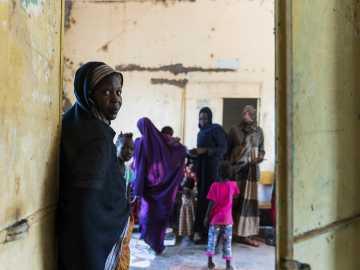Recommendations
The main priority for all actors involved is to ensure that IDPs and host communities have access to livelihood opportunities, adequate housing with security of tenure and basic services using, where appropriate, area-based approaches, particularly:

Governments
- Lead efforts to identify and achieve collective outcomes.
- Integrate collective outcomes within National Development Plans and other relevant plans.
- Adopt normative and institutional frameworks on internal displacement.
- Ensure that municipalities have adequate capacity to address protracted internal displacement.

International humanitarian and development organizations
- Support governmental efforts.
- Integrate collective outcomes into their own planning.
- In the absence of Government:
- Agree on collective outcomes within the UN system.
- Include consultation with relevant authorities and the displacement-affected communities themselves. - Undertake joint analysis in consultation with IDPs and host communities.
- Strengthen Government capacity at all levels.
- Promote and support comprehensive urban-planning approaches.
- Clarify the role of the UN Resident Coordinator/Humanitarian Coordinator (RC/HC) in facilitating multi-stakeholder dialogue to foster collective outcomes.
- Align or ensure complementarity between UN planning instruments and National Development Plans.

Bilateral and multilateral donors and financial institutions
- Direct multi-year, flexible funding towards collective outcomes.
- Reverse the trend of protracted displacement, not only its impact.
- Insist that monitoring and evaluation mechanisms measure the achievement of collective outcomes.
- Allocate development funding to country-level Multi-Partner Trust Funds.
- Consider the use of loans and other financial instruments.
Next steps
RCs/HCs and UN Country Teams
In collaboration with relevant stakeholders, they should undertake concrete action to implement this new approach in three to five selected countries.
8 August 2016, Iraq, Sulaymaniyah: Lise Grande, Humanitarian Coordinator for Iraq, meets with displaced children in Ashti camp in Salaymaniya. Credit: OCHA/Philippe Kropf
UNDP and OCHA
They should develop clear guidance on how to use existing planning tools that explains the steps to reach agreed collective outcomes on protracted internal displacement. They should also create monitoring and evaluation systems.
December 2013: United Nations Resident and Humanitarian Coordinator Luiza Carvalho (left) and Department of Social Welfare and Development (DSWD) Corazon Soliman during a mission to the area devastated by Typhoon Haiyan, Philippines. Credit: OCHA/Gemma Cortes
UN Secretary-General and Deputy Secretary-General
A system-wide internal displacement initiative should be introduced by the UN Secretary-General and his Deputy to implement the diverse set of actions listed above. In addition, the initiative should:
- Include a review of the role of and the contributions to be made by the UN’s peace and security actors.
- Engage with UN donor groups.
The Secretary-General should consider convening a high-level event on the new outcome-oriented approach to protracted internal displacement.
Secretary-General António Guterres visits the camp for displaced people in Hasansham, northern Iraq. The camp was opened by the UN Refugee Agency (UNHCR) in November 2016 to help accommodate people displaced from Mosul since the start of the offensive to retake Iraq’s second city from ISIL the previous month. Credit: UN Photo/Sarmad Al-Safy










